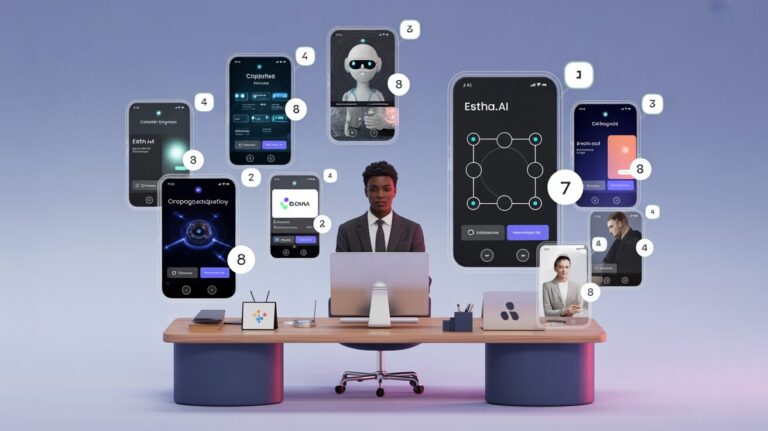Table Of Contents
- Introduction
- Understanding the Basics: What Are Low-Code and No-Code Platforms?
- Key Differences Between Low-Code and No-Code AI
- Benefits and Limitations of Low-Code AI Development
- Benefits and Limitations of No-Code AI Development
- How to Choose the Right Platform for Your Needs
- Real-World Applications of No-Code AI
- The Future of AI Development: Where No-Code is Heading
- Getting Started with No-Code AI Using Estha
- Conclusion
What is Low-Code vs No-Code AI? A Comprehensive Beginner’s Guide
Artificial intelligence once seemed like a technology exclusive to corporations with deep pockets and teams of specialized developers. But today, a revolution is underway that’s democratizing AI development through low-code and no-code platforms. If you’ve been curious about creating your own AI applications but don’t have a computer science degree, you’re in the right place.
The distinction between low-code and no-code AI platforms is crucial for beginners to understand. While both approaches aim to simplify AI development, they offer different levels of accessibility, flexibility, and technical requirements. In this guide, we’ll break down these differences, explore the advantages and limitations of each approach, and help you determine which path aligns best with your goals and technical background.
By the end of this article, you’ll have a clear understanding of how platforms like Estha are transforming the AI landscape by enabling anyone—from content creators and educators to healthcare professionals and small business owners—to harness the power of artificial intelligence without writing a single line of code.
Low-Code vs No-Code AI: Understanding the Difference
A visual guide to choosing the right AI development approach for your needs
Key Differences at a Glance
Low-Code
- Technical Knowledge: Requires basic programming concepts and some coding
- Development Time: Weeks to months depending on complexity
- Flexibility: More control but increased complexity
- Integration: Requires technical understanding of APIs
- Dependency: Still requires technical staff involvement
No-Code (Estha)
- Technical Knowledge: No coding or technical expertise required
- Development Time: 5-10 minutes with Estha’s drag-drop-link interface
- Flexibility: Intuitive customization without coding
- Integration: Simplified with pre-built connectors
- Accessibility: Empowers domain experts to build without technical help
Benefits of True No-Code AI with Estha
Rapid Development
Create custom AI applications in just 5-10 minutes instead of weeks or months
Universal Accessibility
Democratizes AI for anyone with domain expertise, regardless of technical background
Lower Total Cost
Eliminates the need for specialized developers, reducing implementation costs
Expert Integration
Domain experts directly translate their knowledge into AI without technical intermediaries
Real-World Applications with Estha
Content Creation
AI assistants for content ideation and creation
Education
Interactive AI tutors and personalized learning tools
Business
Customer service chatbots and product recommendation engines
Healthcare
Patient education tools and symptom checkers
Ready to Create Your Own AI?
Build custom AI applications in minutes with no coding required
Understanding the Basics: What Are Low-Code and No-Code Platforms?
Before diving into the specific differences between low-code and no-code AI, let’s establish a foundational understanding of these approaches to software development.
The Traditional Development Paradigm
Historically, creating software applications required extensive knowledge of programming languages, development frameworks, and computer science principles. This high barrier to entry meant that only trained developers could build functional applications, creating a significant divide between those with technical skills and those with domain expertise but no coding ability.
Enter Low-Code Platforms
Low-code platforms emerged as a middle ground, offering visual development environments where users could create applications with minimal hand-coding. These platforms typically feature drag-and-drop interfaces, pre-built templates, and components that handle common functions. However, low-code platforms still require some technical understanding and often expect users to modify code for customization or advanced functionality.
With low-code platforms, developers can significantly accelerate application development by automating repetitive tasks while retaining the flexibility to add custom code when needed. This approach reduces development time but still requires a baseline of technical knowledge.
The No-Code Revolution
No-code platforms take accessibility a step further by eliminating the need for any coding whatsoever. These platforms are designed with intuitive, visual interfaces that allow users to create fully functional applications through configuration rather than programming. True no-code solutions prioritize simplicity and usability, enabling subject matter experts to translate their knowledge into working applications without technical assistance.
When applied to artificial intelligence, no-code platforms like Estha are democratizing access to sophisticated AI capabilities that were previously available only to organizations with dedicated data science teams. This democratization represents a fundamental shift in who can create and deploy AI solutions.
Key Differences Between Low-Code and No-Code AI
When specifically looking at AI development platforms, the distinction between low-code and no-code becomes even more significant. Here are the key differences you should understand:
Technical Knowledge Requirements
Low-code AI platforms typically require users to understand basic programming concepts, data structures, and sometimes even machine learning principles. Users often need to write small snippets of code, understand API endpoints, or configure technical parameters like model hyperparameters.
In contrast, true no-code AI platforms like Estha eliminate these technical requirements entirely. With Estha’s drag-drop-link interface, users can create sophisticated AI applications without understanding programming languages, prompting techniques, or machine learning concepts. The platform handles all technical complexities behind the scenes.
Development Speed and Accessibility
Low-code AI platforms accelerate development compared to traditional methods but still involve a learning curve and setup time. Projects typically take weeks or months to complete, depending on complexity.
No-code AI platforms dramatically reduce this timeline. With Estha, users can create custom AI applications in just 5-10 minutes, allowing for rapid prototyping and deployment. This speed makes AI development accessible to professionals who need quick solutions without dedicating extensive time to learning new technical skills.
Flexibility and Customization
Low-code platforms generally offer greater flexibility for highly customized AI solutions. The ability to add custom code provides more control over the fine details of implementation but comes at the cost of increased complexity.
No-code platforms prioritize accessibility over granular control, offering pre-configured components that handle common AI tasks. However, leading no-code platforms like Estha balance simplicity with customization by providing intuitive ways to personalize AI behavior without coding. Through configuration options and visual workflows, users can create AI applications that reflect their unique expertise and brand voice.
Integration Capabilities
Both low-code and no-code platforms offer integration options, but they differ in implementation. Low-code platforms often require technical understanding of APIs, webhooks, and data transformation to connect with other systems.
Modern no-code AI platforms feature simplified integration options through pre-built connectors and user-friendly interfaces for connecting to existing tools and services. This approach allows non-technical users to incorporate AI into their existing workflows without middleware development.
Benefits and Limitations of Low-Code AI Development
Benefits of Low-Code AI
Low-code AI platforms offer several advantages for organizations with some technical resources:
Enhanced Control: The ability to customize through code provides greater control over AI behavior and implementation details. This can be valuable for specialized use cases with unique requirements.
Technical Flexibility: Low-code platforms typically support a wider range of technical integrations and can be extended more easily for complex scenarios.
Performance Optimization: Having access to code allows developers to optimize performance for specific use cases, potentially achieving better results for computationally intensive applications.
Bridge for Technical Teams: Low-code platforms can serve as a middle ground for organizations transitioning from traditional development to more accessible approaches.
Limitations of Low-Code AI
Despite these benefits, low-code approaches have significant limitations:
Technical Barrier Remains: The requirement for some coding knowledge still excludes many potential AI creators who have valuable domain expertise but no programming background.
Longer Development Cycles: While faster than traditional development, low-code AI projects still take considerably more time than no-code alternatives.
Training Investment: Organizations must invest in training staff on both the platform and basic programming concepts, increasing the total cost of ownership.
Dependency on Technical Staff: Maintenance and updates often require technical personnel, creating potential bottlenecks in the development process.
Benefits and Limitations of No-Code AI Development
Benefits of No-Code AI
No-code AI platforms like Estha offer compelling advantages that are transforming who can create AI applications:
Universal Accessibility: No-code platforms democratize AI development, allowing anyone with domain knowledge to create AI solutions regardless of technical background.
Rapid Development: The ability to create functional AI applications in minutes rather than weeks dramatically accelerates innovation and problem-solving.
Lower Total Cost: By eliminating the need for specialized developers, no-code platforms significantly reduce the cost of AI implementation.
Domain Expert Empowerment: Subject matter experts can directly translate their knowledge into AI applications without technical intermediaries, resulting in solutions that better address real-world needs.
Faster Iteration: The simplicity of no-code platforms enables rapid testing and refinement of AI applications, fostering an iterative approach to development.
Limitations of No-Code AI
While no-code AI offers tremendous benefits, it’s important to understand potential limitations:
Customization Boundaries: Some highly specialized AI applications might require capabilities beyond what current no-code platforms offer.
Platform Dependency: Organizations become somewhat dependent on their chosen no-code platform’s capabilities and roadmap.
Perception Challenges: Some stakeholders might initially question whether no-code solutions can deliver enterprise-grade performance and security.
However, leading platforms like Estha are continuously expanding capabilities and addressing these limitations, narrowing the gap between what can be achieved with traditional development versus no-code approaches.
How to Choose the Right Platform for Your Needs
Selecting between low-code and no-code AI platforms depends on several factors specific to your situation:
Assess Your Technical Resources
Take an honest inventory of your technical capabilities. If your team lacks programming experience and you don’t have dedicated developers, a no-code platform will likely be more successful. Even if you have technical staff, consider whether their time is better spent on other initiatives while domain experts build AI applications independently through no-code tools.
Evaluate Your Timeline
How quickly do you need to implement AI solutions? If you’re looking to rapidly prototype or deploy applications, no-code platforms offer a significant advantage. Platforms like Estha reduce development time from months to minutes, allowing you to realize value from AI investments much sooner.
Consider Use Case Complexity
Analyze the complexity of your intended AI applications. Many organizations are surprised by how much can be accomplished with modern no-code platforms. Before assuming you need a low-code solution for complex use cases, explore whether a leading no-code platform can meet your requirements.
Look at Total Cost of Ownership
Consider not just the platform cost but also the resources required for implementation, training, and maintenance. No-code platforms typically have a lower total cost of ownership due to reduced dependence on technical staff and faster development cycles.
Evaluate Future Scalability
Consider your long-term AI strategy. Modern no-code platforms are increasingly designed for enterprise scalability, with robust security features and integration capabilities that support organizational growth.
Real-World Applications of No-Code AI
To better understand the potential of no-code AI platforms like Estha, let’s explore some practical applications across different industries:
Content Creation and Marketing
Content creators can build AI assistants that help generate ideas, create outlines, or provide feedback on drafts. Marketing teams can develop chatbots that qualify leads, answer common questions, and guide prospects through the sales funnel—all without writing code.
Education and Training
Educators can create interactive AI tutors that provide personalized learning experiences, answer student questions outside office hours, and generate practice problems based on individual learning needs. These applications can be customized to match specific curriculum requirements and teaching methodologies.
Healthcare
Healthcare professionals can develop patient education tools, symptom checkers, or medication adherence assistants that reflect their clinical expertise. These AI applications can help extend care beyond office visits while maintaining the provider’s voice and approach.
Small Business Operations
Small business owners can create AI applications that handle customer service inquiries, process routine requests, or provide product recommendations. These tools can embody the business’s unique personality and service approach while operating 24/7.
Professional Services
Consultants, lawyers, financial advisors, and other professionals can build AI advisors that provide preliminary guidance, collect client information, or explain complex concepts. These applications extend the professional’s reach while maintaining their expertise and methodology.
In each of these scenarios, the key advantage of no-code platforms is that the domain experts themselves—not developers—can create AI applications that authentically represent their knowledge and approach.
The Future of AI Development: Where No-Code is Heading
The evolution of no-code AI platforms is rapidly transforming the landscape of artificial intelligence development. Here are some trends shaping the future:
Increasing Sophistication
No-code AI platforms are becoming increasingly powerful, with capabilities that rival custom-developed solutions. As underlying AI technologies advance, these platforms will continue to incorporate cutting-edge features while maintaining their accessibility.
Specialized Industry Solutions
We’re seeing the emergence of no-code AI platforms with pre-built components tailored to specific industries. These specialized tools address common use cases in healthcare, finance, education, and other sectors, further reducing the time to implementation.
AI-Assisted Development
Ironically, AI itself is making no-code platforms even more accessible by providing intelligent assistance during the development process. These AI helpers can suggest components, optimize workflows, and even predict what the user is trying to achieve.
Ecosystem Development
Leading platforms are building comprehensive ecosystems around their no-code tools. Estha exemplifies this approach with EsthaLEARN for education and training, EsthaLAUNCH for startup support, and EsthaeSHARE for monetization and distribution. These ecosystems provide end-to-end support for AI creators.
Enterprise Adoption
As no-code AI platforms prove their value and security, enterprise adoption is accelerating. Organizations are recognizing that empowering non-technical employees to create AI solutions drives innovation and efficiency while reducing IT backlogs.
The future of AI development is increasingly inclusive, with no-code platforms playing a central role in democratizing access to artificial intelligence capabilities. This democratization will unleash creativity and problem-solving from previously untapped sources—domain experts who understand real-world challenges but lack technical development skills.
Getting Started with No-Code AI Using Estha
If you’re interested in exploring no-code AI development, Estha provides an excellent entry point with its intuitive platform designed for non-technical users. Here’s how to begin your journey:
Define Your AI Application Goal
Start by clearly defining what you want your AI application to accomplish. Whether it’s creating a chatbot to answer customer questions, an expert advisor to provide guidance in your field, or an interactive quiz to engage your audience, having a specific goal will guide your development process.
Gather Your Knowledge Assets
Identify the expertise, information, and brand elements you want to incorporate into your AI application. With Estha, you can infuse your AI with your unique knowledge and voice, creating an authentic extension of your expertise.
Explore Estha’s Drag-Drop-Link Interface
Estha’s visual interface allows you to create AI applications by simply dragging components onto the canvas, dropping them into place, and linking them together to create functional workflows. This intuitive approach makes AI development accessible to anyone, regardless of technical background.
Test and Refine Your Application
Once you’ve built your initial AI application, test it thoroughly to ensure it meets your goals. Estha makes it easy to iterate and refine your creation until it perfectly represents your expertise and meets your users’ needs.
Deploy and Share Your AI
After finalizing your AI application, Estha provides multiple options for deployment. You can embed it in your existing website, share it with your community, or even monetize it through the EsthaeSHARE marketplace. This flexibility ensures your AI can reach its intended audience and create value.
Conclusion
The distinction between low-code and no-code AI platforms represents more than just a technical difference—it reflects a fundamental shift in who can participate in the AI revolution. While low-code platforms have reduced some barriers to AI development, they still require technical expertise that limits accessibility.
True no-code platforms like Estha are democratizing AI by enabling anyone with domain knowledge to create sophisticated AI applications without coding skills. This democratization is unleashing creativity and problem-solving from previously untapped sources, allowing experts across all fields to translate their knowledge into functional AI.
As we look to the future, the continued evolution of no-code AI platforms will further bridge the gap between technical capability and domain expertise. Organizations that embrace these tools gain not only efficiency and cost advantages but also the ability to harness the full innovative potential of their entire workforce.
Whether you’re a content creator looking to scale your reach, an educator developing interactive learning tools, or a small business owner seeking to enhance customer service, no-code AI platforms offer an accessible entry point to the transformative power of artificial intelligence. The question is no longer whether you have the technical skills to create AI applications—it’s what problems you want to solve with AI.



